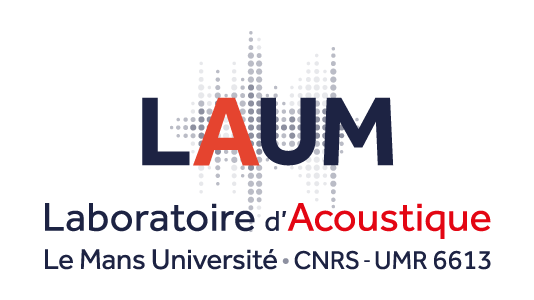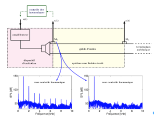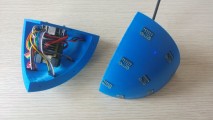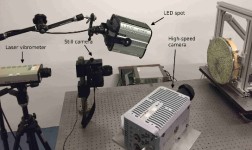Transducers
Transducers
Transducers
This team is mainly interested in transducers (sensors, actuators, energy converters), in the development of measurement benches (digital holography, metrology) and in the associated signal processing.
The studies carried out, both theoretical and experimental, are based on a sharing of fundamental skills of the team members (acoustics, thermics, optics, magnetism, electricity, signal processing,...) and their technological know-how (fine measurements, micro-fabrications in clean room).
Electroacoustic & Audio
The purpose of the ElectroAcoustic and Audio Research Operation (OR-E2A) is the modeling, development and experimental characterization of electroacoustic sources and sensors, whose principles are based on different transduction processes (electrodynamic, electrostatic, piezoelectric, ionic, etc.). The targeted applications concern various fields such as audio, telephony, metrology, etc.
Thus, the topics addressed concern both sources and sensors. Their behavior can be approached as closely as possible: for example by studying the physical principles governing the transducer alone. The insertion of the transducer in more complex systems is also studied (modification of its radiation by acoustic charges). Finally, the networking of loudspeakers or microphones and their control is of particular interest to the OR-E2A.
In the last few years, the following topics have concentrated the activities of the OR-E2A researchers :
- The development of a loudspeaker where the digital-to-analog conversion is performed during the acoustic radiation;
- The characterization of transducer nonlinearities and the understanding of the underlying physical phenomena;
- The methods of fine characterization of loudspeaker systems;
- The development of microphone antennas and adapted signal processing;
- Field synthesis (loudspeaker array control) especially for custom listening area applications.
Optical, Signal and Image Methods for Acoustics
The purpose of the OR Méthodes Optiques, Signal, Image pour l'Acoustique is the development of data analysis algorithms, signal and image processing dedicated to the problems and needs in instrumentation for research in acoustics.
The OR MOSAIC is probably the most transversal of the ORs of the Team with works concerning diagnostics (geophysics, biomedical), non-destructive testing (ultrasonic spectroscopy, algorithms), imaging of acoustic phenomena (optical holography, photogrammetry), machine learning and artificial intelligence applied to sensors and acoustic measurements (statistical models, de-noising).
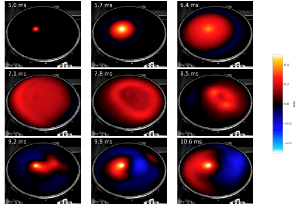 The OR has a transversal vocation with numerous intra- and inter-team collaborations at the LAUM. The strongest singularity of the OR is the emergence of imaging techniques with 3D vision which completes the methods of digital optical holography, thus offering a wide range of methods for diagnosis and full-field measurement of vibratory fields.
The OR has a transversal vocation with numerous intra- and inter-team collaborations at the LAUM. The strongest singularity of the OR is the emergence of imaging techniques with 3D vision which completes the methods of digital optical holography, thus offering a wide range of methods for diagnosis and full-field measurement of vibratory fields.
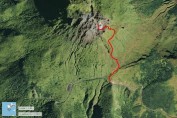 The activities of the OR MOSAIC in signal processing and data analysis concern particularly the medical field, NDT and geophysics. They are declined on several collaborative actions at the international (Italy, Lebanon, Algeria, Tunisia, Saudi Arabia), national (CHU Angers, LARIS, IPGP) and industrial (CIDELEC) levels.
The activities of the OR MOSAIC in signal processing and data analysis concern particularly the medical field, NDT and geophysics. They are declined on several collaborative actions at the international (Italy, Lebanon, Algeria, Tunisia, Saudi Arabia), national (CHU Angers, LARIS, IPGP) and industrial (CIDELEC) levels.
Members : E. Brasseur (IE), M. Feuilloy (MCF), J.-M. Girault (MCF), K. Hassan (MCF), S. Letourneur (IR), R. Longo (MCF, animateur), S. Ménigot (MCF), S. Montrésor (MCF), P. Picart (PR), G. Plantier (PR), K. Raoof (PR), Y. Serrestou (PRAG), L. Simon (PR), R. Da Costa (MCF), R. Feron (MCF).
Sensors & Micro-Sensors
MICA research operation : Micro-sensors and Acoustic Sensors
Integrated into the LAUM's Transducers team (a team that has been present since the beginning of the laboratory), the OR Mica groups together research activities relating to micro-sensors and acoustic sensors. Micro-sensors include sensors and actuators using various types of transduction (thermal, thermo-electric, capacitive, electro-dynamic, piezo-electric, plasma, etc.).
These devices are most often MEMS (Micro-Electro-Mechanical Systems) manufactured in clean rooms for various fields of application including mobile telephony, medical, aeronautics, etc. Collaborations in recent years have been conducted mainly with LNE-CNAM, SATIE-CNAM, CEA Leti, CEA -DAM, SAFRAN aircarft Engines, Université Rennes-1, ESIEE, UB Barcelona, CREMEN Sousse, ENSET-Med.V University Rabat, etc.
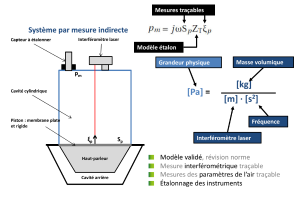 Etalon primaire de capteurs infrasons
Etalon primaire de capteurs infrasons
The systems developed in recent years are (among others) SAW sensors for pollutant detection, micro-antennas for improved breast cancer detection, MEMS microphones for mobile telephony, hybrid acoustic absorbers integrating MEMS technologies, a primary standard for infrasound sensors, ...
 Micro-antennes
Micro-antennes
The design tools used are mainly electro-acoustic models with localised constants, analytical models integrating visco-thermal effects in the boundary layers and multi-physics finite element modelling.
The activities of the R.O. give rise to teaching in the IMDEA Master's programme and at the ENSIM within the IAGS.
Thermo-Acoustic
The thermoacoustic team at LAUM makes research works based on expertise in physical acoustics, instrumentation for acoustics, and electroacoustics.
The researc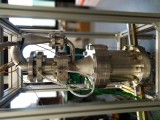 h described here mainly concerns thermoacoustic engines, which are systems allowing the production of work from heat (engine) or conversely the generation of a heat flow (heat pump) induced by sound waves. The studies carried out concern various topics such as the study of different kinds of nonlinear effects (acoustic streaming, aerodynamic and entropic edge effects, non-linear acoustic propagation), the dynamics of these systems, the proposal of new design tools, new measurement techniques, new architectures, active control techniques...
h described here mainly concerns thermoacoustic engines, which are systems allowing the production of work from heat (engine) or conversely the generation of a heat flow (heat pump) induced by sound waves. The studies carried out concern various topics such as the study of different kinds of nonlinear effects (acoustic streaming, aerodynamic and entropic edge effects, non-linear acoustic propagation), the dynamics of these systems, the proposal of new design tools, new measurement techniques, new architectures, active control techniques...
One of the specificities of the research carried out at LAUM is that it integrates both theoretical an experimental aspects, and experimental devices have been developed at LAUM. The research made is essentially oriented towards fundamental aspects, but the team also has technical know-how concerning the design of heat exchangers, the design and fabrication of a complete thermoacoustic system, and the experimental characterization of each of its elements.
